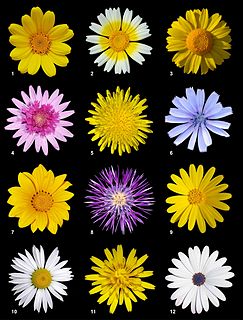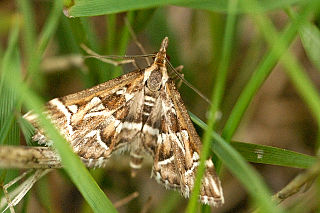
Asterales is an order of dicotyledonous flowering plants that includes the large family Asteraceae known for composite flowers made of florets, and ten families related to the Asteraceae. While asterids in general are characterized by fused petals, composite flowers consisting of many florets create the false appearance of separate petals.

The family Asteraceae, alternatively Compositae, consists of over 32,000 known species of flowering plants in over 1,900 genera within the order Asterales. Commonly referred to as the aster, daisy, composite, or sunflower family, Compositae were first described in the year 1740. The number of species in Asteraceae is rivaled only by the Orchidaceae, and which is the larger family is unclear as the quantity of extant species in each family is unknown.

Amalek was a nation described in the Hebrew Bible as a staunch enemy of the Israelites. The name "Amalek" can refer to the nation's founder, a grandson of Esau; his descendants, the Amalekites; or the territories of Amalek, which they inhabited.

Helminthotheca is a genus in the tribe Cichorieae of the family Asteraceae. Helminthotheca is closely related to the genus Picris, both within the Hypochaeridinae subtribe.

Picris (oxtongues) is a genus of flowering plants in the family Asteraceae described as a genus by Linnaeus in 1753.
Harold Ernest Robinson was an American botanist and an entomologist.

Eupatorieae is a tribe of over 2000 species of plants in the family Asteraceae. Most of the species are native to tropical, subtropical, and warm temperate areas of the Americas, but some are found elsewhere. Well-known members are Stevia rebaudiana, a number of medicinal plants (Eupatorium), and a variety of late summer to autumn blooming garden flowers, including Ageratum (flossflower), Conoclinium (mistflower), and Liatris.

The Thompson Chain-Reference Bible is a Christian study Bible published by the Kirkbride Bible Company now published by Zondervan.

Picris hieracioides, or hawkweed oxtongue, is a species of flowering plant in the family Asteraceae.

The Cichorieae are a tribe in the plant family Asteraceae that includes 93 genera, more than 1,600 sexually reproductive species and more than 7,000 apomictic species. They are found primarily in temperate regions of the Eastern Hemisphere. Cichorieae all have milky latex and flowerheads that only contain one type of floret. The genera Gundelia and Warionia only have disk florets, while all other genera only have ligulate florets. The genera that contain most species are Taraxacum with about 1,600 apomictic species, Hieracium with about 770 sexually reproducing and 5,200 apomictic species, and Pilosella with 110 sexually reproducing and 700 apomictic species. Well-known members include lettuce, chicory, dandelion, and salsify.

The Cichorioideae are a subfamily of the family Asteraceae of flowering plants. Familiar members of Cichorioideae include lettuce, dandelions, chicory and Gazania species. The subfamily comprises about 240 genera and about 2900 species. It is heterogeneous and hard to characterize except with molecular characters.
Rune Bertil Nordenstam is a Swedish botanist and professor emeritus at the Swedish Museum of Natural History in the Department of Phanerogamic Botany. He has worked with Colchicaceae, Senecioneae and Calenduleae, was the editor of Compositae Newsletter newsletter since 1990, and is a Tribal Coordinator for The International Compositae Alliance with responsibility for the tribes Calenduleae and Senecioneae.

Diasemia reticularis is a species of moth of the family Crambidae. It is typically found in the tropics, but may range into Europe as far north as the North Sea region because of its migratory nature.

Helminthotheca echioides, known as bristlyoxtongue, is a stiff annual or biennial herb native to Europe and North Africa. It was traditionally used as an antihelminthic treatment.

The University of Southern Mindanao, formerly Mindanao Institute of Technology (MIT), is a university in the Southern Philippines. It provides instruction and professional training in the fields of science and technology, particularly agriculture and industry. The university was founded by Bai Hadja Fatima Matabay Plang, an educator and philanthropist. It formally open on October 1, 1954, and achieved university status on March 13, 1978. Its 1,024 hectare main campus is located in Kabacan, Cotabato. The University of Southern Mindanao is one of the four State University and Colleges (SUC) to achieve excellence in agricultural education and one of the nine to hold Level IV status. Across its 3 campuses USM holds a total of 5,129.97 hectares of land, mostly for agricultural teaching and research.

Pogonolepis is a genus of Australian plants in the tribe Gnaphalieae within the family Asteraceae.

Crombrugghia distans, also known as the Breckland plume is a moth of the family Pterophoridae found in Africa, Asia and Europe. It was first described by Philipp Christoph Zeller in 1847.

Cochylis hybridella is a moth species of the family Tortricidae. It is found in most of Europe, the Near East, China, Japan, Korea and Russia.

Joachim Steetz was a German botanist. His herbarium, comprising more than 5000 specimens from over 160 collectors and 30 countries was purchased in 1863 by Victorian Government Botanist Ferdinand von Mueller for the sum of 80 pounds. The collection is currently housed at the National Herbarium of Victoria. The herbarium was compiled by Steetz over more than thirty years and comprises 160 collectors from more than 30 countries, including type specimens from plant collectors of the time including:

Vicki Ann Funk was an American botanist and curator at the Smithsonian's National Museum of Natural History, known for her work on members of the composite family (Asteraceae) including collecting plants in many parts of the world, as well as her synthetic work on phylogenetics and biogeography.















